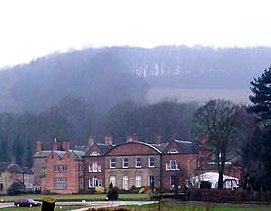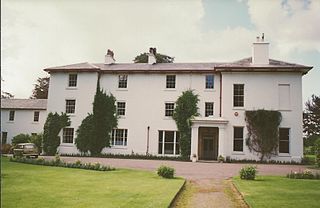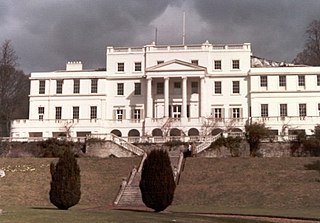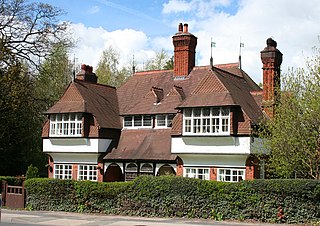
Lyme Park is a large estate located south of Disley, Cheshire. The estate is managed by the National Trust and consists of a mansion house surrounded by formal gardens, in a deer park in the Peak District National Park. The house is the largest in Cheshire, and is recorded in the National Heritage List for England as a designated Grade I listed building.

The Earl of Conway was an aristocratic title in the Peerage of England. The earldom was created in 1679 for Edward Conway, 3rd Viscount Conway (c.1623-1683), subsequently Secretary of State for the Northern Department. When Edward Conway died in 1683, he had no heir and the title automatically became extinct.
Sir Hugh Conway was created Lord Treasurer of Ireland in 1494 by King Henry VII of England. He replaced Sir James Ormonde as Lord Treasurer of Ireland. In 1504 he was appointed Treasurer of Calais by Henry VII. Hugh Conway was an early supporter of Henry Tudor, Earl of Richmond, was sent by Margaret Beaufort, Henry's mother to Henry, in exile in France, in 1483 with a large sum of money and encouragement to invade England through Wales and seize the crown from Richard III. Henry did so in 1485 and Richard was killed at the Battle of Bosworth, where Hugh was present. Hugh was appointed Keeper of the Great Wardrobe by King Henry VII on 21 September 1485, was knighted in January 1486 at the coronation of Queen Elizabeth of York, daughter of King Edward IV. Sir Hugh Conway was appointed Sheriff of Buckinghamshire and Bedfordshire by Henry VII in 1500. Sir Hugh was a son of John ‘ Aer Conwy Hen ’ of Bodrhyddan Hall and Constable of Rhuddlan Castle, Flintshire, Wales, by his first marriage, and descended from the ancient line of Conway and de Crevecouer. Sir Hugh's younger half-brother was Edward Conway who married the heiress of Arrow and Alcester, Warwickshire, and was great-grandfather to Edward Conway, 1st Viscount Conway of Ragley Hall, ancestor of the present family of Seymour Conways, Marquis of Hertford.

Plas Newydd is a country house set in gardens, parkland and surrounding woodland on the north bank of the Menai Strait, in Llanddaniel Fab, near Llanfairpwllgwyngyll, Anglesey, Wales. The current building has its origins in 1470, and evolved over the centuries to become one of Anglesey's principal residences. Owned successively by Griffiths, Baylys and Pagets, it became the country seat of the Marquesses of Anglesey, and the core of a large agricultural estate. The house and grounds, with views over the strait and Snowdonia, are open to the public, having been owned by the National Trust since 1976.

Bodysgallen Hall is a manor house in Conwy county borough, north Wales, near the village of Llanrhos. Since 2008 the house has been owned by The National Trust. It is a Grade I listed building, currently used as a hotel. This listed historical building derives primarily from the 17th century, and has several later additions. Bodysgallen was constructed as a tower house in the Middle Ages to serve as defensive support for nearby Conwy Castle. According to tradition, the site of Bodysgallen was the 5th century AD stronghold of Cadwallon Lawhir, King of Gwynedd, who had wide ranging exploits as far as Northumberland.

Hornby Castle is a country house, developed from a medieval castle, standing to the east of the village of Hornby in the Lune Valley, Lancashire, England. It occupies a position overlooking the village in a curve of the River Wenning. The house is recorded in the National Heritage List for England as a designated Grade I listed building.

Hopton Hall is an 18th-century country house at Hopton, near Wirksworth, Derbyshire. It is a Grade II listed building.

Mere Old Hall is a 17th-century country house which stands to the west of the village of Mere and the junction of the A566 and A50 roads in Cheshire, England.

Duxbury Hall was a 19th-century country house in Duxbury Park estate in Duxbury Woods, Lancashire that has been demolished.

Linton Park, formerly Linton Place or Linton Hall, is a large 18th-century country house in Linton, Kent, England. Built by Robert Mann in 1730 to replace an earlier building, the house and estate passed through the ownership of several members of Mann's family before coming into the Cornwallis family. The house was enlarged to its current size in 1825.

Quernmore Park Hall is a grade II* listed Georgian country house which stands in a 20-acre estate in the village of Quernmore, part of the City of Lancaster district of England.

Summerhill House was a 100 roomed mansion which was the ancestral seat of the Viscounts Langford and the Barons Langford. Built in 1731, Summerhill House demonstrated the power and wealth the Langford Rowley family had at the time. They owned vast amounts of land in counties Meath, Westmeath, Cork, Londonderry, Antrim, and Dublin as well as in Devon and Cornwall.
Rear-Admiral Rafe Grenville Rowley-Conwy, CMG, was a Royal Navy officer and Lord Lieutenant of Flintshire.
Maenan Hall is a Grade I-listed hall house located north west of the village of Llanddoged, Conwy, Wales. This late medieval country mansion has fine decorative plasterwork and was the home of the Kyffin family. It is currently in private ownership but the extensive gardens are open to the public on a few occasions each year.
Hon. Richard Thomas Rowley was a British Conservative Party politician.

Haynes Park is a Georgian country house which stands in parkland at Haynes Church End, Bedfordshire, England. It is a Grade I listed building.

















